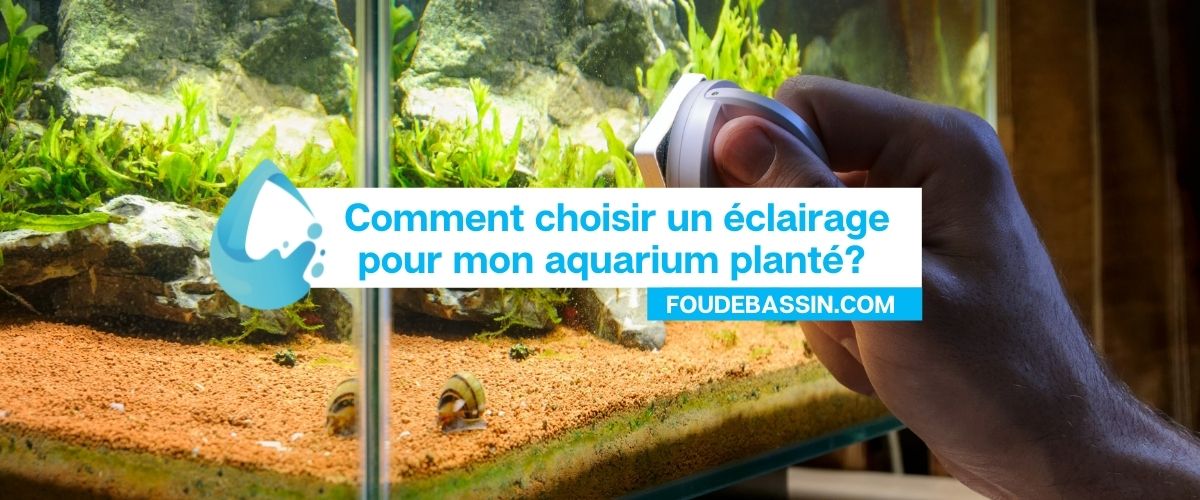Retrouvez ici les indispensables et meilleures ventes pour nos propriétaires de bassin.
Retrouvez ici les indispensables et meilleures ventes pour nos propriétaires de bassin.

What led lighting for a planted aquarium? How to choose lighting for an aquarium? How to choose lighting for an aquarium with plants? Light is essential for the development of your aquatic plants in the aquarium. It is she who will regulate the biological balance of your mini ecosystem. These lights in fresh water, just like in salt water, contribute to the growth of your plants and your corals.
It also helps to highlight the color of your fish. It is often supplied with your aquarium. Most aquariums are equipped with tubes, but we are seeing more and more LED ramps appear.
It is important to bring light to your aquarium. The assimilated light will allow the plant to transform the CO2 into usable energy for its development. If like us, you went to school a bit :-) You may have heard about photosynthesis in your notebooks. We will not blame you if these notions no longer mean anything to you.
Photosynthesis is actually the transformation of carbohydrate molecules which instead feeds and oxygen molecules released into your aquarium. Lighting an aquarium is not only aesthetic. Fish do not have eyelids. So, it's complicated to close your eyes to sleep :-) If you manage to sleep without closing your eyes, you are one of the rare human specimens to sleep with your eyes open like a fish.
In general, an aquarium is lit 10 to 12 hours a day to respect a classic biological cycle. You should know that lighting is essential for the development of plants and fish. The role of lighting for plants allows them to develop and create photosynthesis. Too much light will promote the development of green algae.
Do you have brown algae? Analyze the water and increase the lighting by one hour per day in your aquarium.
Alternating between day and night is essential for a good balance in your aquarium . This is especially important for your plants and fish. Use a timer to make your job easier. To define a day and night cycle, it is recommended to light your aquarium 10 hours a day.
There are new and old methods.
These T5 tubes are fitted to most current aquariums.
The star of the moment is the LED or sometimes LED ramps for the aquarium. However, it is more complicated to repair an LED ramp if one of the LEDs burns out on your ramp. It heats very little and consumes very little. Its price is more and more affordable.
There are also two lighting technologies used in terrariums and aquariums, HQL & HQI lamps. These two techniques consume a lot of energy and are gradually being replaced by ramps or LED lighting. The characteristics are often the same for the different types of lighting.
On a fluorescent or compact fluorescent tube , you have several parameters to take into account, the lumens, the K (color temperature of the aquarium), the power (expressed in W). CRI allows you to know the quality of the lamp.
We no longer address the power in W. It was with the old T8 tubes but it is no longer valid with the LED. We now use lumens & K. So how many lumens for my aquarium?

How many K (kelvin - lighting temperature)?
The most used on the market for a classic aquarium with a few plants, you will be able to satisfy yourself with 6500K lighting. It is one of the most used colors.
It is a color that reproduces the lighting of the sun. In fresh water, some go down to 5000 KELVINS to approach a pinkish tint and promote the growth of plants in the aquarium.
In seawater, lighting tends towards white (above 10,000K) to promote coral growth.
In saltwater aquariums, corals need light for growth. We no longer speak of power in W but rather of power in K and lumens.
It is one of the least expensive solutions, but the lighting of your interior or the sun is not always sufficient, especially in a reef aquarium. Daylight is not enough to illuminate an aquarium, especially if it has a cover. You must adapt the quantity and power of your lighting according to the type of fish and aquatic plants selected.
Aquipond Greenstab - Natural treatment against pond algae It is a natural product that helps limit algae at any time. It also has a prevent...
View full detailsReduces the layer of silt in the pond by at least 40% Easy to use with less impact on biodiversity Prevents fermentation, bad odors. pH ...
View full detailsOrganic dye to block plant growth by limiting photosynthesis ORGANIC PRODUCT NON TOXIC TO HUMANS (DIVING) AND FISH. 100% NATURAL AND BIODE...
View full detailsThe positive effects of barley straw have been known to water enthusiasts for a long time. But currently barley straw is difficult to find and i...
View full detailsReduces at least 40% of the layer of silt in the pond Easy to use with less impact on biodiversity Prevents fermentation, bad odors. ...
View full details
Leave a comment